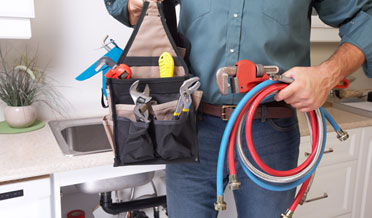Plumbing Repair Overview

Plumbing Repair
Have you ever noticed the “No Dumping/Leads to Stream” signs attached to municipal storm drains? This is an important notification since water collected by storm drains is not treated before it enters the nearest body of water. We should take the same approach when it comes to the drains in our homes and plumbing repair.
The wastewater that leaves our home is transported to a wastewater treatment plant. It may be the small variety, say a septic tank in the backyard, or a big plant that handles millions of gallons per day. But we should give a thought to what we dump down the drain and how we care for our sewer lines. Consider these facts:
Plumbing Repair Service or Lateral Lines
For most municipalities, the homeowner is responsible for the portion of the sewer system under private property. Any repairs or replacement of a service line is generally the homeowner’s responsibility. Make sure you know a few things about it.
- You should know the general vicinity of the line, that is, in which direction it runs. Backyard? Front yard?
- It is in your best interest to know the composition of the line. Is it made of PVC or clay?
- It is good to know of trees and shrubs in the general area of your service line. Roots can infiltrate the line, seeking nutrient-rich water. The roots will eventually clog the pipe and must be dealt with.
Plumbing Repair for Garbage Disposals
Chances are, you learned what NOT to put in a garbage disposal AFTER you put it into the garbage disposal; oh, what a mess they can make. Most plumbers would encourage a small compost bin and discourage heavy use of the garbage disposal.
- What you put into the garbage disposal matters. It is not a trash compactor or a rotary tiller. Avoid putting large items or items in large quantities.
- Not everything that CAN be put in a disposal SHOULD be put in a disposal. More about this is coming.
What Not to Flush: Obvious Things that Cause Plumbing Repair Issues
Sometimes things are put in the drain by accident. Sometimes, it seemed like a good idea at the time, but the results lead to the conclusion that it was a mistake. Here are some obvious things not to put in a drain:
- Foreign Materials, including toys and socks. Also, avoid dropping phones and iPods into the toilet.
- Kitty Litter. Litter is designed to absorb moisture and swell as it does. It is also heavy, and the swollen mass can result in a clog.
- Drain cleaner. Yes, that is right. The harsh, volatile chemicals can damage pipes and be hazardous to the water supply. There are better methods to remove clogs in pipes.
- Harsh chemicals. Do not pour paint, petroleum products, or harsh cleaners down your drain.
What Not to Flush: Not So Obvious Things
Many things that you CAN put down the drain should NOT be put down the drain. Most of these items are responsible for major clogs that can cause backups.
- Common health care products. Condoms and feminine hygiene products should not be flushed. Oddly, enough, your plumber will tell you not to flush “flushable wipes.” These items can get snagged and restrict or clog water flow.
- Sticky food items. Fat, oil, and grease are notorious for adhering to pipes, becoming solid, and trapping other items to the bottom or sides of drain pipes. Starchy foods, such as rice and potatoes, have the same effect.
- Small food items. Coffee grounds, tea leaves, and eggshells commonly adhere to fats and starches clinging to the pipes, resulting in bigger clogs.
- Fibrous foods. Vegetable peels and ends are notorious for producing drain clogs.
- Whenever possible, use a trap to collect hair before it gets into the drainpipe.
Let Us Answer Your Plumbing Repair Questions
Let Doctor Cool help with your Plumbing Repair questions. Call Doctor Cool & Professor Heat today at 281-338-8751 or email Doctor Cool and let our professional Residential Plumbing Contractors assist with all of your Drain Cleaning questions.

